|
Thurs., May 10
1:00 p.m.
ALCPG ILC Physics and Detector Seminar - West Wing, WH-10NW
Speaker: J. Hauptman, Iowa State University
Title: Hadronic Calorimetry: As Easy As 1, 2, 3 ... Readouts
2:30 p.m.
Theoretical Physics Seminar - WH-3NW (NOTE LOCATION)
Speaker: B. Mukhopadhyaya, Harish-Chandra Institute, India
Title: Dogs That Do Not Bark: Right-Handed Neutrinos in a Supersymmetric World
3:30 p.m.
DIRECTOR'S COFFEE BREAK- 2nd Flr X-Over
THERE WILL BE NO ACCELERATOR PHYSICS AND TECHNOLOGY SEMINAR TODAY
Fri., May 11
3:30 p.m.
DIRECTOR'S COFFEE BREAK - 2nd Flr X-Over
4:00 p.m.
Joint Experimental-Theoretical Physics Seminar - Auditorium (NOTE LOCATION)
Speaker: J. Feng, University of California, Irvine
Title: Supersymmetric Dark Matter
Announcement
The Hunt for Dark Matter: A Symposium on Collider, Direct and Indirect Searches will be held at Fermilab from Thursday, May 10 through Saturday, May 12. Click here for more information.
Click here for NALCAL,
a weekly calendar with links to additional information. |
Thursday, May 10
-Tomato florentine
-Grilled chicken Cordon Bleu sandwich
-Chimichangas
-Smart Cuisine: Chicken marsala
-Smoked turkey melt
-Assorted pizza slices
-SW chicken salad w/ roasted corn salsa
Wilson Hall Cafe Menu |
|
Thursday, May 10
Dinner
- Salad of field greens w/ jicama, radishes, oranges, pine nuts & queso rico
w/ balsamic vinaigrette
- Beef short ribs in chipotle green chili sauce
- Cumin roasted sweet potatoes
- Strawberry sorbet w/ lemon sugar cookies
Wednesday, May 16
Lunch
- Grilled flank steak
- Jasmine rice
- Pea pods & mushrooms
- Chocolate almond mousse
Chez Leon Menu
Call x4598 to make your reservation. |
|
|
CD1 approval recommended
for Dark Energy Camera
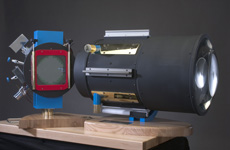 A model of the Dark Energy Survey instrument.
A model of the Dark Energy Survey instrument.
At the conclusion of an intense three-day review of the Dark Energy Survey project, the chair of the joint DOE/NSF review panel announced that it will recommend to DOE and NSF that DOE approve Critical Decision 1 for the DOE contribution to the DES project, the Dark Energy Camera project at Fermilab. If granted, CD1 approval will allow scientists and engineers to refine the design and budget of the project and prepare for the next stage of the process.
The DES collaboration proposes to explore the presence of dark energy in our universe in new ways. To achieve its scientific goals, the collaboration plans to conduct a ground-based experiment that includes building the Dark Energy Camera and installing it on the Blanco Telescope on Cerro Tololo in Chile.
A dozen astronomers and engineers came to Fermilab last week to help DOE and NSF review the DES project. They reviewed the plans for all aspects of the entire survey that were drawn up by the 100-member DES collaboration. Among the three main components, they examined the plans to build DECam, a digital camera with 520 megapixels, at Fermilab, using charged-coupled devices (CCDs).
"The project has the competence and an adequate plan to procure, test and integrate sufficient CCDs into the focal plane [of the camera]," said panel member Roger Smith, Caltech, during the review closeout session. "Our single greatest concern is still the uncertainty in yield of acceptable CCDs."
The panel made a large number of detailed recommendations on all aspects of the Dark Energy Survey, from technology to schedule, providing the project team with in-depth guidance for meeting the goals of future reviews. If the project passes all future reviews, has the necessary funding and receives final approval, the proposed camera could be delivered to Cerro Tololo in 2010.
"I would like to thank the panel members for the faith they have placed in us," said John Peoples, DES Project Director. "We're going to work hard to carry out the recommendations."
The Dark Energy Camera project receives funding from DOE, NSF, the UK Science and Technology Facilities Council, the Ministerio de Educacion y Ciencia in Spain, the FINEP agency of the Ministry of Sciences and Technology of Brazil as well as in-kind contributions from DES member institutions in the United States and other countries.
To learn more about the DOE Critical Decision review process, click here for a previous article in Fermilab Today.
-- Kurt Riesselmann
|
Researchers flock to Fermilab
to discuss dark side of matter
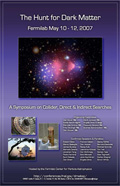 |
| A poster advertising the dark matter symposium. |
Scientists have long known that there is more in space than meets the eye. The quest for knowledge about matter that we cannot see continues this week as Fermilab hosts "The Hunt for Dark Matter: A Symposium on Collider, Direct and Indirect Searches." From Thursday morning through Saturday afternoon, about 170 researchers and scientists from around the globe will gather for a series of presentations and panel discussions on field research and progress.
Although other conferences and symposia have addressed the hunt for dark matter, Fermilab's Dan Bauer, chair of the local organizing committee, believes that this week's symposium is one of the first comprehensive gatherings. "Other dark matter workshops tend to be more topical, addressing only the theory, direct detection, collider, or astronomical aspects of the hunt," Bauer said. "The idea here was to bring together researchers from all of these fields." By gathering in one place, scientists have the chance to meet on a more individual basis to discuss their research.
Fermilab is the perfect venue for this event, Bauer said, because of the multiple facilities and researchers dedicated to discovering more about dark matter. "We have a very good outlook of finding out what dark matter is," Bauer said. "We think we're close."
Included in the events this week will be a reception Thursday night and a keynote speech Friday at 4 p.m. by Jonathan Feng titled "Supersymmetric Dark Matter." There will also be a panel discussion on Friday evening. Bauer said the symposium, although quite technical, is open to employees and the public. Online registration is closed, but anyone interested in attending can sign up at the registration desk this morning.
-- Rhianna Wisniewski
|
40 years after farms left land,
farming community remains
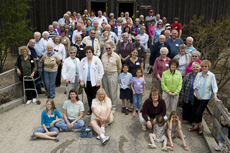 Members of the former farming community on Fermilab property and their family members at the 10th annual Fermilab Farmer's Picnic on Saturday, May 5.
Members of the former farming community on Fermilab property and their family members at the 10th annual Fermilab Farmer's Picnic on Saturday, May 5.
Out near Butterfield Road, secluded from most of Fermilab, sits Leonard Baumann's rickety red barn. Baumann, like 55 other farmers, relocated around the Batavia area to make way for Fermilab's construction 40 years ago. Today, grasses have overtaken their farms and barns have been destroyed, but the farming community survives.
Nearly 100 people gathered at last Saturday's 10th annual Fermilab Farmers' Picnic to celebrate their decades-old farming community. "I come back every year to see old friends," Baumann said. "We are all farmers. We're older than rocks." He will be 85 in two weeks.
Inside Kuhn Barn, visitors were treated to a spread of treats, including a farm-scene cake, complete with a barn and rows of crops. Roads & Grounds' Bob Lootens drove a group of about 10 partygoers around the lab. "I'm going to take you down memory lane," he said as the bus turned onto Holter Road inside the Tevatron's main ring.
Prairie burns have thinned out the forest, making look as it did in the past-even the same gravel roads are there. "It's like a time capsule," Lootens said.
For the farming community, the Farmers' Picnic is a chance to reconnect with those who used to live on the now Fermilab grounds. Baumann looks up his friends every once and a while, but he depended on them most when he had open heart surgery. "They were there to support me," he said.
Flanked by relatives, Baumann pointed out people he knew as partygoers walked past, including a 96-year-old woman for whom he had baled hay when he was younger.
A former babysitter, Janet L. Mish also remembered life on the farm. "I babysat for a lot of the people who lived on these farms. I miss these people," she said. Mish left her Eola Road farm more than 40 years ago.
Some from the farming community can recognize patches of grass where their barns once sat. Baumann's barn is still standing, although it is showing signs of its nearly 100 years and might have to be torn down for safety concerns.
-- Kate Raiford
|
|
|
CHAMP sent to corner
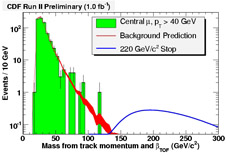
The observed (green) and predicted (red) distribution of CHAMP candidate masses measured using the particle velocity and momentum. A stable stop squark with a mass of 220 GeV/c2 would populate the plot as indicated by the blue curve.
The collisions of protons and antiprotons within the Tevatron may
produce new elementary particles which cannot be explained by our
current Standard Model. Typically, these exotic new particles are
expected to live only momentarily -- some only as long as 10-25 seconds! -- and decay long before they reach any detector. Every year,
physicists at CDF and DZero sift through billions of collisions looking for hints of the debris left by exotic decays.
Under some circumstances, however, these massive particles can have lifetimes ranging anywhere from a few nanoseconds to near infinity.
In such cases, these particles would streak through the detector
without decaying, and standard search techniques would miss them, even
if they are produced copiously.
CDF has recently extended its search for new particles to include charged,
massive stable particles (CHAMPs), which could exist at masses well below
current limits for unstable particles. The analysis focuses on the low
velocity characteristic of such massive particles. Specialized
time-of-flight detectors located about 1.5m from the collisions allow the
measurement of particle velocities with high precision. Using both the
measured velocity and momentum, the mass of a candidate particle can be
calculated. Particles with mismeasured velocity, which could otherwise
mimic a CHAMP, tend to have a low mass when calculated in this way.
By comparing the observed data with the predicted rate from mis-measurements,
CDF sets an upper bound on the rate at which heavy-weight CHAMPs are produced.
For the specific case of a long-lived "stop squark" (the partner of the top
quark in supersymmetric extensions to the Standard Model), CDF has
excluded their existence for masses below 250 GeV/c2, a dramatic
improvement in the previous limit near 100 GeV/c2 set by the Large Electron-Positron Collider at CERN.
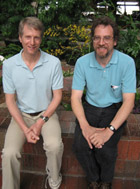
| Searching for CHAMPs: Rick Snider (Fermilab), Tom Phillips (Duke). |
Learn More
|
New weapons in the battle against hospital superbugs
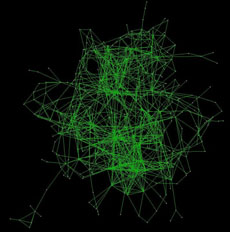 |
| Each point represents a protein expressed in the bacterium Pseudomonas aeruginosa; each line represents known interactions between these proteins. This network shows the structure of interactions the cell depends upon, giving researchers a head start in the search for anti-bacterial drugs.
Image courtesy of e-Therapeutics |
For the first time in decades researchers have announced the discovery of new antibiotics that use a truly novel approach in attacking bacteria. The grid-powered drug searches were conducted by a spin-out company from Newcastle University in the United Kingdom. E-Therapeutics found three new drugs that are effective against antibiotic-resistant superbugs, such as that scourge of hospitals, methicillin-resistant Staphylococcus aureus.
The drugs entered clinical trials in February and should be available for use within two to three years. The techniques that enabled this discovery were developed by the UK e-Science Programme, coordinated by the UK's Research Councils and the Department of Trade.
Read More
|
Nature.com
May 8, 2007:
Particle physicists hunt for the unexpected
How do you search for something when you don't know what you're looking for?
Most physicists at Illinois-based Fermilab, home to the world's most powerful particle collider, share a dream. They hope against hope that the Tevatron will find the long-sought Higgs particle before the much more powerful Large Hadron Collider (LHC) at CERN - the European particle-physics laboratory outside Geneva, Switzerland - comes along in a year or so and eats their lunch. Bruce Knuteson, though, has a fear. What if the LHC finds something even more exotic than the Higgs -and the tell-tale traces of that novelty turn out to have been lurking, unrecognized, in Fermilab's data for years?
Read more |
|
National Bike to Work Week
Riding your bicycle to work is a great way to get some exercise, save money on gas and reduce stress. May 14-18 is National Bike-to-Work week so dust off that bicycle and re-discover the excellent trails in and around the lab. Sign up and record your mileage here or by email.
Folk Club Barn Dance
The Fermilab Folk Club will host a barn dance on Sunday, May 13 at 6:30 p.m. with music by Jordan & Barbie and calling by Paul Watkins. More info is available online.
Fermi Singers concert
Mark your calendars! The Fermi Singers will be holding a concert on May 25 at noon in Ramsey Auditorium. Treats are available after the concert.
A Brief Introduction to Mathematica 6
ESH will provide training, titled "A Brief Introduction to Mathematica 6" on June 4, from 3:00 p.m.- 5:00 p.m. This class will provide direct experience with all of the basic features of Mathematica 6, as well as a foundation for developing advanced applications of the system. Learn more and enroll.
What's New in Mathematica 6?
ESH will provide training, titled "What's New in Mathematica 6?" on June 4, from 1:00 p.m.- 2:30 p.m. The seminar will display and explain the new visualization power and the dynamic capabilities new to Mathematica 6. Other topics will include high performance computing and gridMathematica. There is no cost for this seminar or the following training. Learn more and enroll.
May 16: Employee Health & Fitness Day
On May 16, from 11:30 a.m. - 1:00 p.m., the Recreation Office will sponsor the National Employee Health & Fitness Day Event. Walk, run, or bike your way around the ring. This year's theme will be "Safety at Home." A table will be set up at A1 for participants to sign in and pick up their game ticket and a bottle of water. The largest percentage of participation from Divisions and Sections will win the traveling trophy. Rain date will be May 17.
|
|